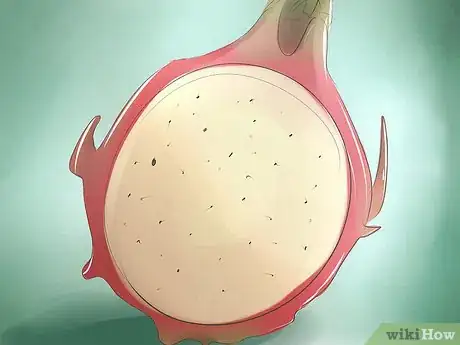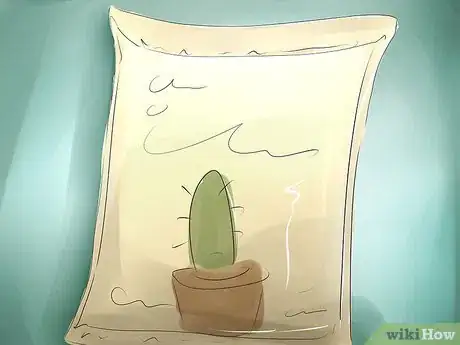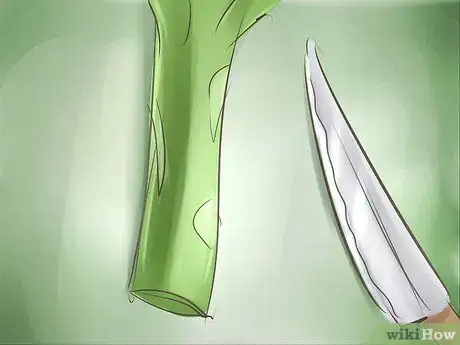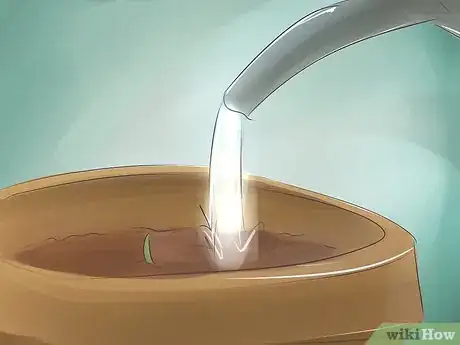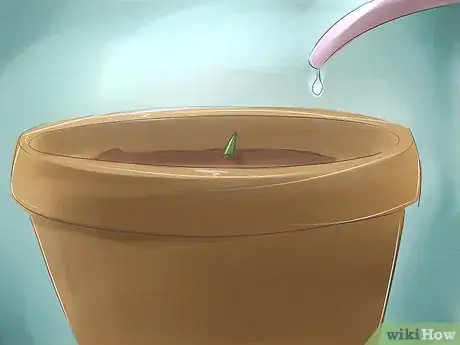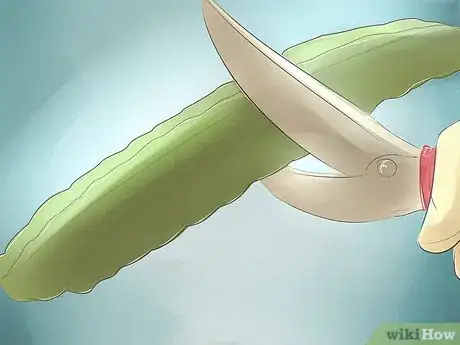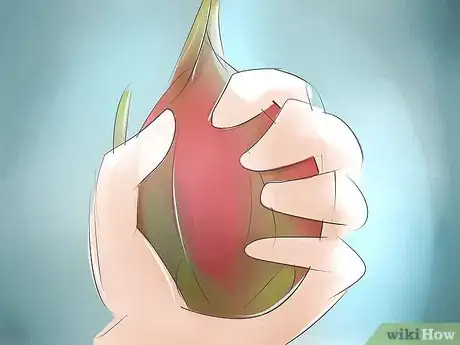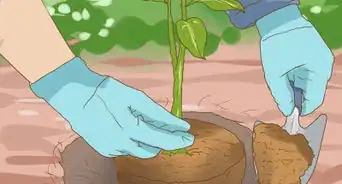This article was co-authored by Andrew Carberry, MPH. Andrew Carberry is a Food Systems Expert and the Senior Program Associate at the Wallace Centere at Winrock International in Little Rock, Arkansas. He has worked in food systems since 2008 and has experience working on farm-to-school projects, food safety programs, and working with local and state coalitions in Arkansas. He is a graduate of the College of William and Mary and holds a Masters degree in public health and nutrition from the University of Tennessee.
wikiHow marks an article as reader-approved once it receives enough positive feedback. This article received 22 testimonials and 94% of readers who voted found it helpful, earning it our reader-approved status.
This article has been viewed 496,960 times.
Pitaya, or dragon fruit, is a tasty treat that most people know for its fire-like appearance. These fruits grow on Hylocereus cacti and, with some tender loving care, you can plant and cultivate them at home.
Steps
Choosing the Right Set-Up
-
1Choose between dragon fruit seeds or cuttings from an already developing plant. Which one you choose all depends on time. If you're growing dragon fruit from seeds, it could be two years or so before your plant bears any fruit.[1] If you grow from the cuttings of a stem, it could take much less time (depending on how large your cutting is).
- Growing from seed isn't harder, for the record. It just takes more time.
- Professional growers sell dragon fruit plants that are ready to be transplanted to your garden. Just be careful as you're taking them out of the pot, to ensure that you don't damage the seedlings.
-
2Determine whether you're going to grow the plant outdoors or indoors, openly or in a container. Believe it or not, dragon fruit can grow just fine in containers. If you do use a container, use one that's 15" to a 24" in diameter, and at least 10"+ deep, fitted with a climbing pole. However, the plant will likely eventually grow to a point that it needs a bigger pot, so be prepared to transplant it when that happens.
- If your plant is going to be outside (whether it's in a container or not), choose a place that's at least partly sunny. The roots can be in the shade, but the tips of the plant need to be in the sun to bloom.[2]
- If you live in a warm area with a long, warm growing season, this plant could sustain being outside. They can generally handle a very light frost, but that's it. If your area has a decent winter, bring it inside.
Advertisement -
3Use well-drained, sandy cactus soil. After all, technically this plant is a cactus. The last thing you want to use is a wet, mucky soil. They are light feeders that don't need a lot of nutrient love. Plant them in an area of your garden where water doesn't tend to pool. If you get a lot of rainfall in your area, plant the dragon fruit plant on a hill or mound, so that the water drains away.[3]
- If you're planting in a container, grab a large one with drainage holes at the bottom. If you don't have cactus soil available, you can come up with your own by using a mixture of sand, potting soil, and compost. Fill it up a few inches (7cm) away from the brim of the pot.
Planting and Caring for Your Dragon Fruit
-
1Let cuttings dry before planting. If you obtain a fresh cutting, it is best to let it dry in a cool, shady spot for about a week. This will allow the wound to heal and prevent infection once it is planted.
-
2Plant in full sun. The leaves of the plant should be exposed to full sun for best results. Make sure it's still getting adequate sunlight as it grows.[4]
-
3Plant flush with the soil line. If you're using cuttings or a farm-ordered plant from a box, take it carefully from its container and replant it flush with its new soil line. If you're using seeds, sprinkle a few into each container and cover lightly with soil.
- As for seeds, you'll have to wait and see which ones take. In a few weeks, you'll have sprouts and they'll likely need separated. If not, they may not reach their full potential.
- Consider mixing a small amount of slow time release fertilizer into the lower level of the soil before planting; this may help your plant grow faster.[5]
-
4Fertilize only occasionally. Even a cutting will take up to four months to get a good, strong root system going.[6] However, when it comes to fertilizers, be wary: too much can easily kill your plant. For best results, feed them a little slow-time release, low-nitrogen cactus fertilizer only about once every two months. You may be tempted to do more to see more immediate growth, but it won't help.[7]
-
5Water the dragon fruit plant in the same manner as a tropical cactus. In other words, only give it a little water when it's practically dry. If your plant is large enough by now to have a climbing pole, keep the climbing pole moist. A dripper would be useful in this situation.
- Overwatering is possibly the most common reason plants die. Don't be tempted; they don't need it. If you're using a pot, keep in mind how it drains. If there are no drain holes, it needs even less; otherwise the water will just stay in the bottom and lead to rot and decay.
Harvesting the Fruit
-
1Watch the dragon fruit plant grow. While your plant may take a couple of years to get fully going, some hit giant spurts where they can grow a foot in a week. When it does start developing, you may want to use a climbing pole to give it structure. This can help it reach its full potential without it breaking or weighing itself down.
- If you've planted your dragon fruit plant from seeds and they're now visibly growing, separate them into their own pots. They need their own turf to grow and flourish.
- You'll notice a bloom start to develop over the course of many weeks. However, it will only actually bloom for one night (yep, it's nocturnal) so you'll likely miss it in its full glory. Many are self-pollinating (if it's not you can try hand-pollination; brush the pistil's natural pollen down into the inside of the flower).[8] If a fruit is going to develop, you'll notice the flower wither and the base of the bloom begin to swell. [9]
-
2Prune the plant. Dragon fruit plants can get quite large; some varieties can even reach upwards of 20 feet (6.1 m).[10] When it gets too large, start pruning it by cutting off some branches. Less weight may actually get it stronger, concentrate the nutrients, and encourage it to flower.
- You don't necessarily have to throw the branches away! You can either repot them yourself and grow another plant (they will take root virtually effortlessly) or give them away as a gift.
-
3Pick the fruit in the later half of the year. Dragon fruit usually produces ripe fruit in late summer or fall, but can fruit at almost any time of year if it receives enough water and warmth. You can tell that a dragon fruit is ripe when the skin turns red or yellow, depending on variety. The skin will also feel slightly soft when squeezed, but not mushy.[11]
-
4Eat up. You've been waiting years for this moment, so savor it. You can cut the fruit into quarters and tear off the rind or just dig into it with a spoon. It's sweet and has a texture that resembles kiwifruit but it's a little crunchier.
- Once in full production, you could see four to six fruit-bearing cycles per year. They amp up eventually; it just takes them a little while to get there. So don't think your first fruit will be your last. You've waited patiently and now abundance is your reward.[12]
Expert Q&A
Did you know you can get expert answers for this article?
Unlock expert answers by supporting wikiHow
-
QuestionCan a dragon fruit tree grow in Austin TX outside?
 Andrew Carberry, MPHAndrew Carberry is a Food Systems Expert and the Senior Program Associate at the Wallace Centere at Winrock International in Little Rock, Arkansas. He has worked in food systems since 2008 and has experience working on farm-to-school projects, food safety programs, and working with local and state coalitions in Arkansas. He is a graduate of the College of William and Mary and holds a Masters degree in public health and nutrition from the University of Tennessee.
Andrew Carberry, MPHAndrew Carberry is a Food Systems Expert and the Senior Program Associate at the Wallace Centere at Winrock International in Little Rock, Arkansas. He has worked in food systems since 2008 and has experience working on farm-to-school projects, food safety programs, and working with local and state coalitions in Arkansas. He is a graduate of the College of William and Mary and holds a Masters degree in public health and nutrition from the University of Tennessee.
Food Systems Expert
-
QuestionCan dragon fruit grow in Memphis, TN?
 Andrew Carberry, MPHAndrew Carberry is a Food Systems Expert and the Senior Program Associate at the Wallace Centere at Winrock International in Little Rock, Arkansas. He has worked in food systems since 2008 and has experience working on farm-to-school projects, food safety programs, and working with local and state coalitions in Arkansas. He is a graduate of the College of William and Mary and holds a Masters degree in public health and nutrition from the University of Tennessee.
Andrew Carberry, MPHAndrew Carberry is a Food Systems Expert and the Senior Program Associate at the Wallace Centere at Winrock International in Little Rock, Arkansas. He has worked in food systems since 2008 and has experience working on farm-to-school projects, food safety programs, and working with local and state coalitions in Arkansas. He is a graduate of the College of William and Mary and holds a Masters degree in public health and nutrition from the University of Tennessee.
Food Systems Expert
-
QuestionCan I grow it in coastal areas?
 Community AnswerYes, I have one that covers the trunk of a palm tree at about twenty feet tall. We have used hedge trimmers to cut it back lest it take over the palm. It produces beautiful huge yellow flowers, but in fifteen years it has only produced two fruits.
Community AnswerYes, I have one that covers the trunk of a palm tree at about twenty feet tall. We have used hedge trimmers to cut it back lest it take over the palm. It produces beautiful huge yellow flowers, but in fifteen years it has only produced two fruits.
Warnings
- The plants can handle temperatures up to 40°C (104°F) and very short periods of frost, but will not survive long exposure to freezing temperatures.⧼thumbs_response⧽
- Overwatering or excessive rainfall can cause the flowers to drop and its fruit to rot.⧼thumbs_response⧽
References
- ↑ http://www.miamiherald.com/2014/07/26/4254594/dragon-fruit-surprisingly-easy.html
- ↑ http://www.mattslandscape.com/hylocereus_info/
- ↑ http://www.mattslandscape.com/hylocereus_info/
- ↑ http://botanicalgrowersnetwork.net/znetsol/1-ProductPages/Dragon/default.p.htm
- ↑ http://botanicalgrowersnetwork.net/znetsol/1-ProductPages/Dragon/default.p.htm
- ↑ http://www.miamiherald.com/2014/07/26/4254594/dragon-fruit-surprisingly-easy.html
- ↑ http://botanicalgrowersnetwork.net/znetsol/1-ProductPages/Dragon/default.p.htm
- ↑ http://www.thekitchn.com/summer-gardening-handpollinati-57513
- ↑ http://www.mattslandscape.com/hylocereus_info/
About This Article
To grow a dragon fruit plant, otherwise known as a Hylocereus cactus, start by filling a gardening pot with well-drained, sandy cactus soil. Then, grab either dried cactus cuttings or dragon fruit seeds and plant them flush with the soil line. Make sure you sprinkle the soil with a small amount of water whenever it gets dry, though be careful not to overwater it. If your plant has trouble growing, try adding slow-time release, low-nitrogen cactus fertilizer to the soil once a month. For tips from our reviewer on how to prune your plant and harvest its fruit, read on!
